Early Custom Car Color Photos
EARLY CUSTOM CAR COLOR PHOTOS
A closer look at the Color photos taken of Custom Cars in the early developing years of the Color Photography. Pre 1950 Early Custom Car Color photos.
The Color photo technique became available to the public in 1935. At first only as color slides, and later in the early 1940’s color prints were developed. Due to the relatively high costs the color photography did not really became a “standard” for regular use until the later part of the 1950’s. Still there were many professional and amateur photographers all over the world experimenting with color photography. Mostly used for family photos, and early magazine prints, but some of the early Car guys also started to experiment with color photography. We all have seen the amazing color slides taken of the 1940’s dry lake races by Don Cox. beautiful Kodak color slides capturing the colorful work of Hot Rods. However for unknown reasons not to many color photos were taken of the Custom Car scene in the 1940’s and even in the early 1950’s.
It is kind of sad that not more color photos were taken of the Custom Cars in this period. We all have heard the stories on the mile deep organic colors created by the Ayala and Barris shops. Yes we only have very few color photos showing these actual colors. After I had done an article about a series of three color photos taken in 1949 at the Edison Substaion in Inlewood Ca. we recieved several emails asking us about more color photos of the early Custom Cars. So then the idea for this article submerged. Pre 1950 color photos of Custom Cars. I have collected some of the better color photos I was able to find of Custom Cars from this period. I wish there were many more, since it really is amazing to see these car in full color taken at the time they were just finished. So every now and then some new material surfaces, and I hope that the future will bring us more color photos of the early Custom Cars.
 1939 unopened Kodak Kodachrome box (images from http://retinarescue.com/)
1939 unopened Kodak Kodachrome box (images from http://retinarescue.com/)
[divider]
Color film since the 1930s
In 1935, American Eastman Kodak introduced the first modern “integral tripack” color film and called it Kodachrome, a name recycled from an earlier and completely different two-color process. Its development was led by the improbable team of Leopold Mannes and Leopold Godowsky, Jr. (nicknamed “Man” and “God”), two highly regarded classical musicians who had started tinkering with color photographic processes and ended up working with the Kodak Research Laboratories.
Kodachrome had three layers of emulsion coated on a single base, each layer recording one of the three additive primaries, red, green, and blue. In keeping with Kodak’s old “you press the button, we do the rest” slogan, the film was simply loaded into the camera, exposed in the ordinary way, then mailed to Kodak for processing. The complicated part, if the complexities of manufacturing the film are ignored, was the processing, which involved the controlled penetration of chemicals into the three layers of emulsion. Only a simplified description of the process is appropriate in a short history: as each layer was developed into a black-and-white silver image, a “dye coupler” added during that stage of development caused a cyan, magenta or yellow dye image to be created along with it. The silver images were chemically removed, leaving only the three layers of dye images in the finished film.
Initially, Kodachrome was available only as 16mm film for home movies, but in 1936 it was also introduced as 8mm home movie film and short lengths of 35mm film for still photography. In 1938, sheet film in various sizes for professional photographers was introduced, some changes were made to cure early problems with unstable colors, and a somewhat simplified processing method was instituted.
In 1936, the German Agfa followed with their own integral tripack film, Agfacolor Neu, which was generally similar to Kodachrome but had one important advantage: Agfa had found a way to incorporate the dye couplers into the emulsion layers during manufacture, allowing all three layers to be developed at the same time and greatly simplifying the processing. Most modern color films, excepting the now-discontinued Kodachrome, use the incorporated dye coupler technique, but since the 1970s nearly all have used a modification developed by Kodak rather than the original Agfa version.
 1946 flyer for Kodak Kodachrome Film for full-color pictures.
1946 flyer for Kodak Kodachrome Film for full-color pictures.
[divider]
In 1941, Kodak made it possible to order prints from Kodachrome slides. The print “paper” was actually a white plastic coated with a multilayer emulsion similar to that on the film. These were the first commercially available color prints created by the chromogenic dye coupler method. In the following year, Kodacolor film was introduced. Unlike Kodachrome, it was designed to be processed into a negative image which showed not only light and dark reversed but also complementary colors. The use of such a negative for making prints on paper simplified the processing of the prints, reducing their cost.
The expense of color film as compared to black-and-white and the difficulty of using it with indoor lighting combined to delay its widespread adoption by amateurs. In 1950, black-and-white snapshots were still the norm. By 1960, color was much more common but still tended to be reserved for travel photos and special occasions. Color film and color prints still cost several times as much as black-and-white, and taking color snapshots in deep shade or indoors required the use of flash bulbs, an inconvenience and an additional expense. By 1970, prices were coming down, film sensitivity had been improved, electronic flash units were replacing flash bulbs, and in most families color had become the norm for snapshot-taking. Black-and-white film continued to be used by some photographers who preferred it for aesthetic reasons or who wanted to take pictures by existing light in low-light conditions, which was still difficult to do with color film. They usually did their own developing and printing. By 1980, black-and-white film in the formats used by typical snapshot cameras, as well as commercial developing and printing service for it, had nearly disappeared. (source Wikipedia)
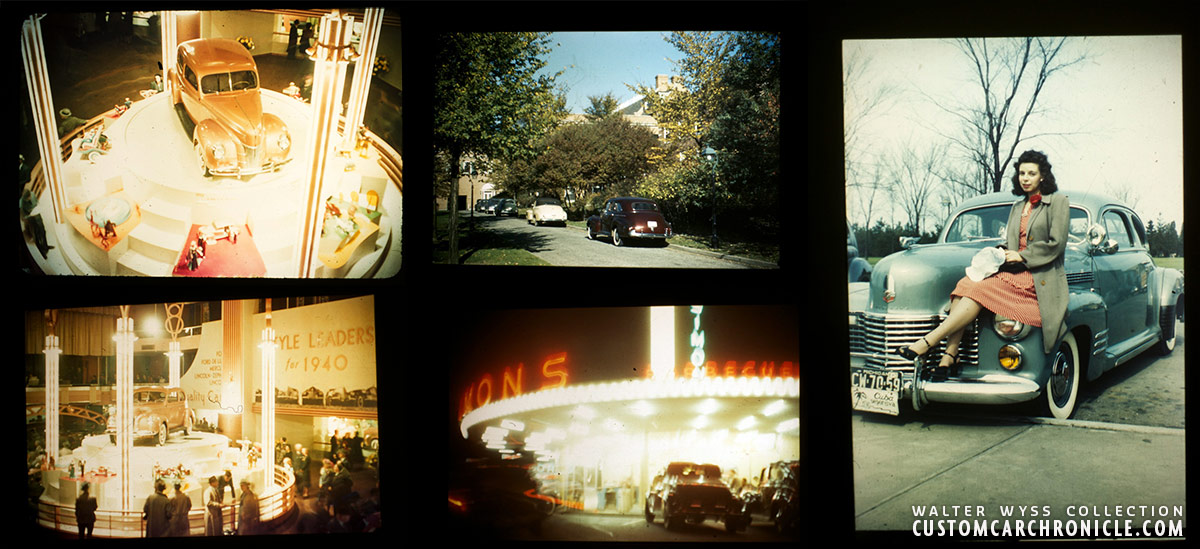 One of the many early users of Kodak Color material was Walter Wyss, who emigrated from Switzerland to the US in the late 1930’s. He took many color slides in the late 1930’s and early 1940’s. But sadly for us, he did not move to sunny California until 1950. There he took some color photos of some Hot Rods and Custom Cars, but as far as we know, none before he moved out west. More about Waltery Wyss can be found in several of CCC Articles on his collections and work.
One of the many early users of Kodak Color material was Walter Wyss, who emigrated from Switzerland to the US in the late 1930’s. He took many color slides in the late 1930’s and early 1940’s. But sadly for us, he did not move to sunny California until 1950. There he took some color photos of some Hot Rods and Custom Cars, but as far as we know, none before he moved out west. More about Waltery Wyss can be found in several of CCC Articles on his collections and work.
[divider]
Custom Car Color Photos
In this article I like to stay focused on pre-1950 taken color photos. The 1936 – 1949 time frame in which color film was available was an extremely interesting period in the history of Custom Cars. The time where the base for it all took shape. The more color photos we find from this period, the more we get to know how the style evolved on the years. So far the very first color photo of a Custom Car I have come across was taken in 1945, at least the license plate on the car, the Jimmy Summers 1940 Mercury is from 1945. I like to think there will be more, and hopefully older color photos of the beautiful styled cars from the early 1940’s. Hopefully one day they will surface. Lets take a look at those that I have gathered for this article.
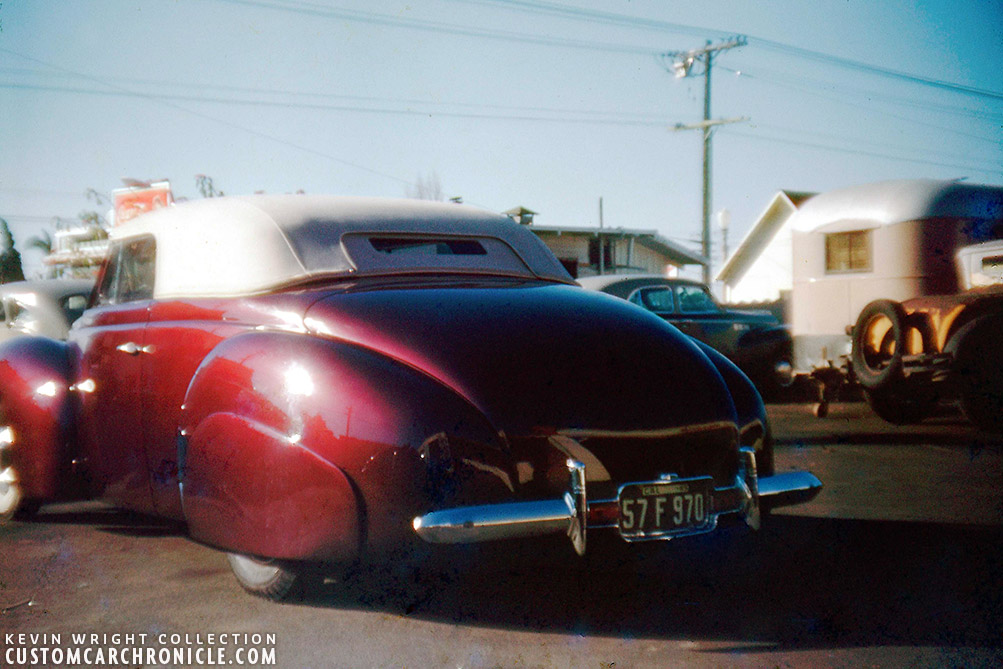 Kevan Wright came across some very unique early photos, slides and negatives. This color slide taken in 1945 is, so far, the earliest color photo I have come across taken from a Custom Car. The car in the picture is the freshly finished Jimmy Summers ’40 Mercury.
Kevan Wright came across some very unique early photos, slides and negatives. This color slide taken in 1945 is, so far, the earliest color photo I have come across taken from a Custom Car. The car in the picture is the freshly finished Jimmy Summers ’40 Mercury.
[divider]
 Dick Page shared this great color photo of Jimmy Summers posing with his wife in front of his ’40 Mercury Custom taken in 1946. (The scan was made from a photo printed from a scan of the original slide.)
Dick Page shared this great color photo of Jimmy Summers posing with his wife in front of his ’40 Mercury Custom taken in 1946. (The scan was made from a photo printed from a scan of the original slide.)
[divider]
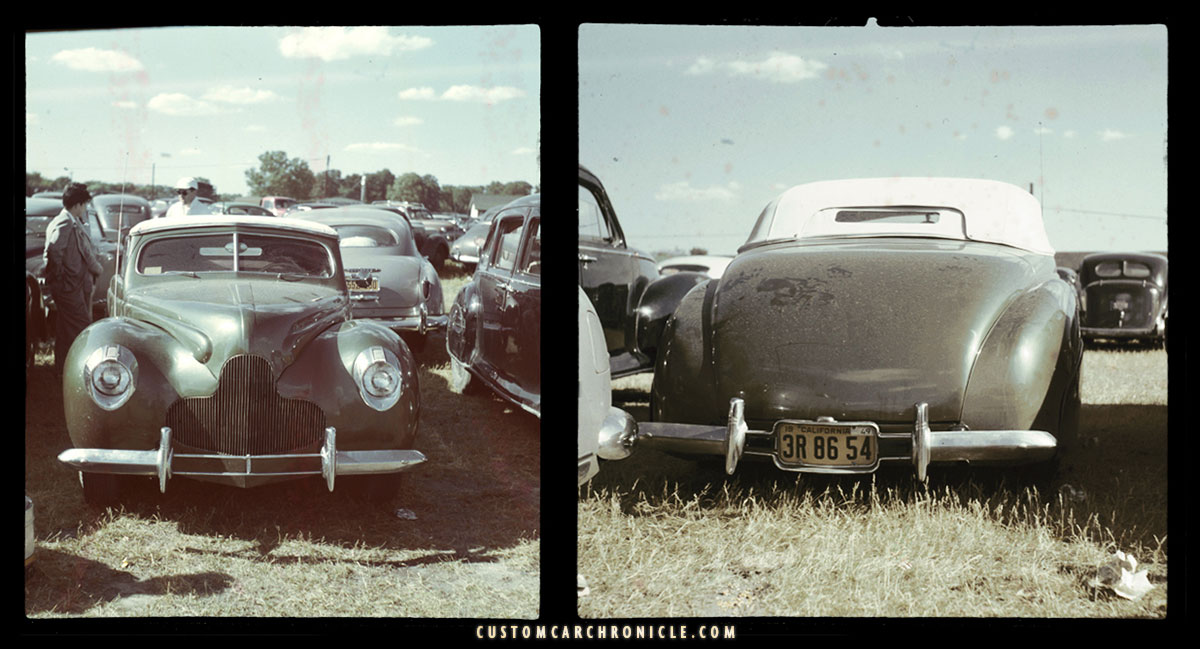 Two faded color show the Jimmy Summers ’40 Mercury in its new Buick Green paint-job. The color slides were taken in 1949.
Two faded color show the Jimmy Summers ’40 Mercury in its new Buick Green paint-job. The color slides were taken in 1949.
[divider]
 Wally Welch’s 1941 Ford was custom restyled at the Gil Ayala body shop. Gil painted Wally’s Ford in what he called a Devil Red color. Wally had a few small color photo prints in his collection. They were sadly all faded quite a bit. This small round corner print shows Wally’s Ford in its early version with stock grille sides which were later replaced with a 1942 Ford grille. This photo comes from 1947.
Wally Welch’s 1941 Ford was custom restyled at the Gil Ayala body shop. Gil painted Wally’s Ford in what he called a Devil Red color. Wally had a few small color photo prints in his collection. They were sadly all faded quite a bit. This small round corner print shows Wally’s Ford in its early version with stock grille sides which were later replaced with a 1942 Ford grille. This photo comes from 1947.
[divider]
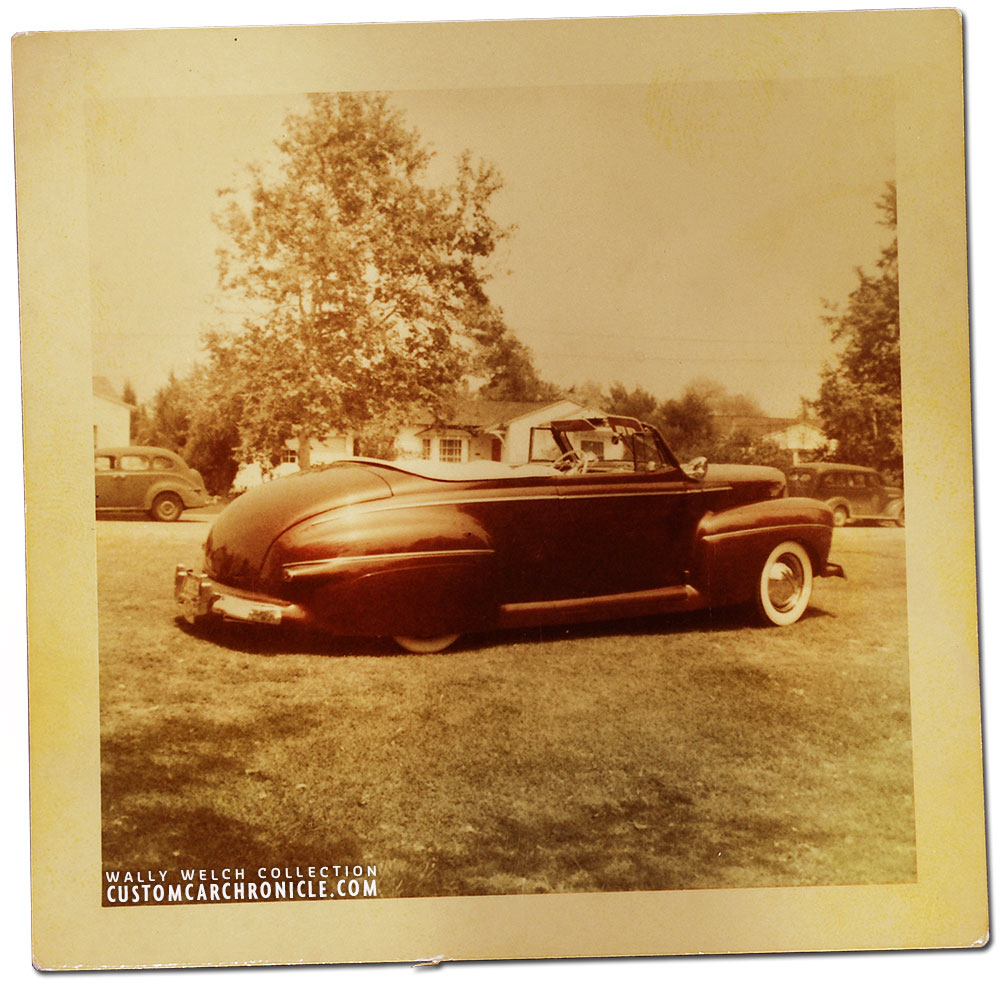 This squire badly faded and yellowed color photo shows the later version of Wally Welch’s ’41 Ford. This photo print was made in late 1949.
This squire badly faded and yellowed color photo shows the later version of Wally Welch’s ’41 Ford. This photo print was made in late 1949.
[divider]
 Jim Skonzakes had several of the color slides he made in the late 1940’s transferred to the Kodak Full-Color-Prints. This sample shows Jim’s 1941 Ford photographed in late 1948. Jim had the 14 x 11 inch Kodachrome Enlargement prints made in January 1949.
Jim Skonzakes had several of the color slides he made in the late 1940’s transferred to the Kodak Full-Color-Prints. This sample shows Jim’s 1941 Ford photographed in late 1948. Jim had the 14 x 11 inch Kodachrome Enlargement prints made in January 1949.
[divider]
 These Kodak enlargement prints are developed onto a thin plastic sheet, and are built up of layers that create the final, very accurate, colors. This image shows an enlarged section of the ’41 Ford photo (top left corner) and shows how the layers started to peel away after 60 plus years. The inset photo shows the Kodachrome Enlargement stamp on the backside of the photo.
These Kodak enlargement prints are developed onto a thin plastic sheet, and are built up of layers that create the final, very accurate, colors. This image shows an enlarged section of the ’41 Ford photo (top left corner) and shows how the layers started to peel away after 60 plus years. The inset photo shows the Kodachrome Enlargement stamp on the backside of the photo.
[divider]
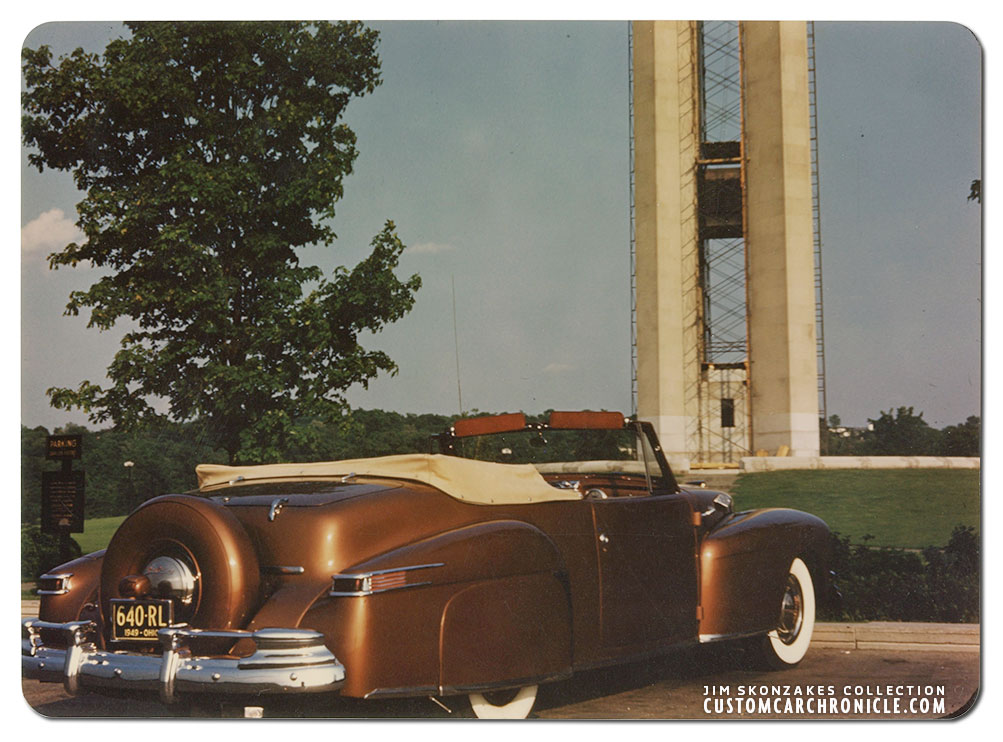 Another Kodachrome Enlargement print from Jim Skonzakes shows Jim’s mildly restyled ’48 Lincoln Continental. These early large color prints show very nice colors, even after more than 6 decades.
Another Kodachrome Enlargement print from Jim Skonzakes shows Jim’s mildly restyled ’48 Lincoln Continental. These early large color prints show very nice colors, even after more than 6 decades.
[divider]
 Al Twitchell’s 1941 Plymouth Custom with full fade-away fenders was painted light blue. Al had a couple of color slides made of his car which were used to create this small size color print in the late 1940’s. The color print, from an unknown manufactory, has been faded badly over the years. More on Al’s Plymouth can be found found in THIS CCC article.
Al Twitchell’s 1941 Plymouth Custom with full fade-away fenders was painted light blue. Al had a couple of color slides made of his car which were used to create this small size color print in the late 1940’s. The color print, from an unknown manufactory, has been faded badly over the years. More on Al’s Plymouth can be found found in THIS CCC article.
[divider]
 Alex Xydias owned this nicely restyled ’34 Ford Cabriolet in the mid to later part of the 1940’s. His Ford had work done by Jimmy Summers and the Valley Custom Shop, who ended up painting the car gold metallic as it is shown in this faded color photo from 1948-49.
Alex Xydias owned this nicely restyled ’34 Ford Cabriolet in the mid to later part of the 1940’s. His Ford had work done by Jimmy Summers and the Valley Custom Shop, who ended up painting the car gold metallic as it is shown in this faded color photo from 1948-49.
[divider]
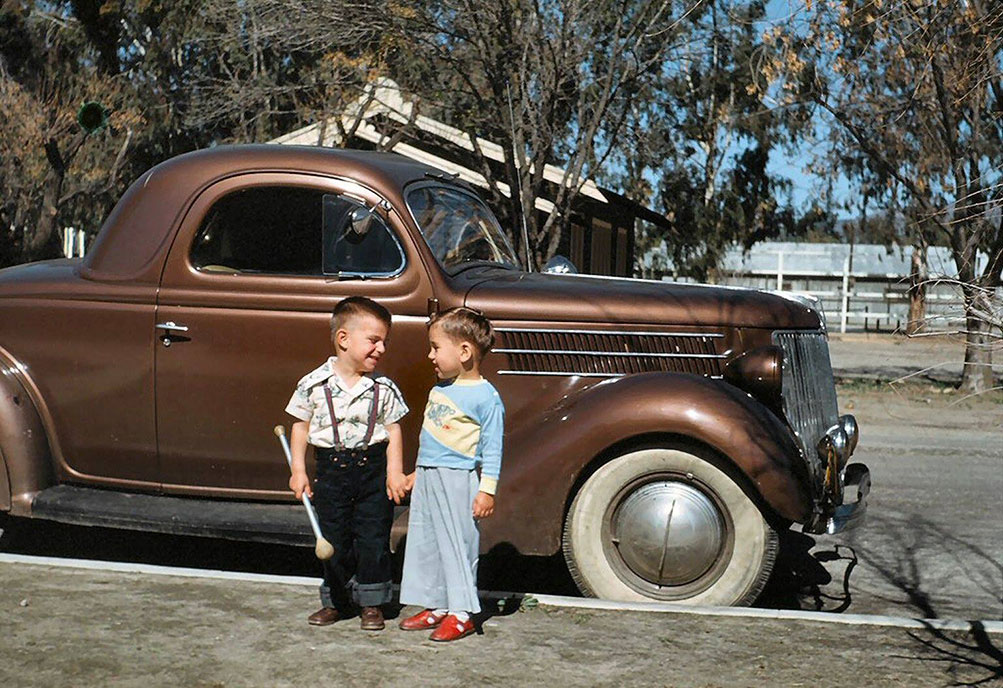 1936 Ford Coupe mildly restyled Custom color slide from the late 1940’s.
1936 Ford Coupe mildly restyled Custom color slide from the late 1940’s.
[divider]
 Frank Kurtis completely rebodies 1941 Buick Custom Sports-Car which he painted bright red. The color print was made in the late 1940’s and has lost some of its color over the years.
Frank Kurtis completely rebodies 1941 Buick Custom Sports-Car which he painted bright red. The color print was made in the late 1940’s and has lost some of its color over the years.
[divider]
 Lynn Yakel’s 1936 Ford photographed in color next to Gil Ayala’s shop in East Los Angeles. The Ford was painted a beautiful coper color.
Lynn Yakel’s 1936 Ford photographed in color next to Gil Ayala’s shop in East Los Angeles. The Ford was painted a beautiful coper color.
[divider]
 Color photo of a 1941 Ford (or Mercury) taken in front of the Gil Ayala Auto Body Works Shop shows a beautiful bronze/coper paint-job. The color slide was taken between 1948-49.
Color photo of a 1941 Ford (or Mercury) taken in front of the Gil Ayala Auto Body Works Shop shows a beautiful bronze/coper paint-job. The color slide was taken between 1948-49.
[divider]
At the end of 1949 several Barris Customs created Custom Cars are being photographed for future Motor Trend Magazine feature articles. As far as we can tell some of the photos were shot in black and white and at least one shot of each car was done in color. More about this unique photo session can be ready in the Edison Location article here on the Custom Car Chronicle. From this photoshoot at least three color photos survived, and they give us a really fantastic look at the rich paint colors used by the Barris Customs Shop in the later part of the 1940’s.
 Vic Grace 1941 Buick with an amazing deep blue-green metallic paint job.
Vic Grace 1941 Buick with an amazing deep blue-green metallic paint job.
[divider]
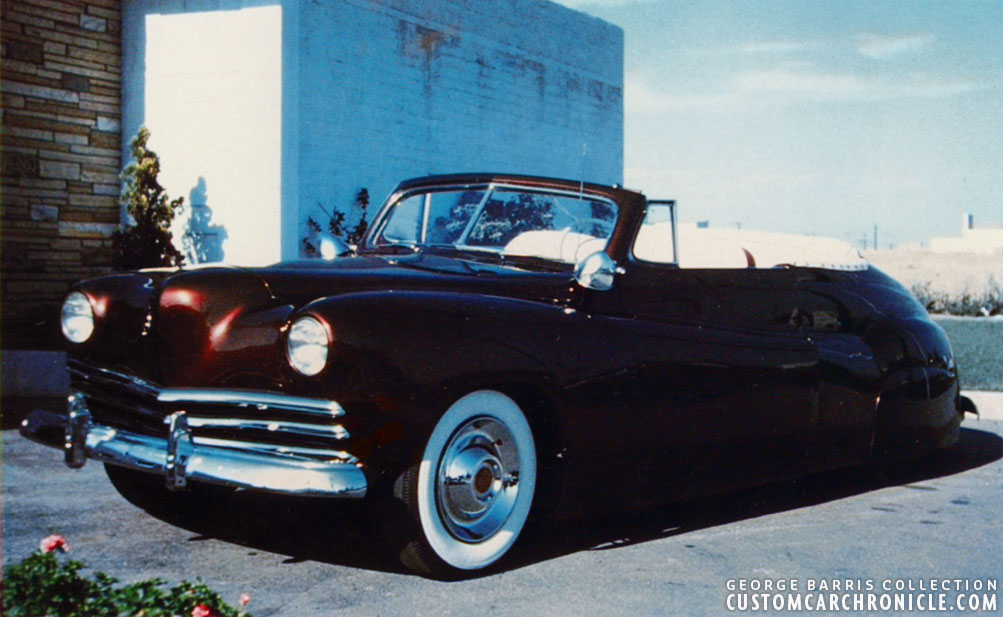 Johnny Zaro’s 1941 Ford Convertible with a deep maroon paint job.
Johnny Zaro’s 1941 Ford Convertible with a deep maroon paint job.
[divider]
 Dick Carter’s 1941 Ford was painted a super deep dark maroon with gold Powder added for some extra sparkle.
Dick Carter’s 1941 Ford was painted a super deep dark maroon with gold Powder added for some extra sparkle.
[divider]
 Robert Genat’s book The Birth of Hot Rodding shows an large selection of amazing color slides taken by Don Cox in the late 1940’s very early 1950’s. While the book obviously concentrates on Hot Rods, there are a few late 1940’s Custom Cars to be seen in the background of some of the books color photos.
Robert Genat’s book The Birth of Hot Rodding shows an large selection of amazing color slides taken by Don Cox in the late 1940’s very early 1950’s. While the book obviously concentrates on Hot Rods, there are a few late 1940’s Custom Cars to be seen in the background of some of the books color photos.
[divider]
More Early Custom Car Color Photos?
We are always looking for more early color photos of Custom Cars. So if you have some in your collection, or if you know about some early color photos of Custom Cars from another collection. Please contact Rik here at the Custom Car Chronicle, so that we can add them to this article, or perhaps do new article showing more of these amazing early Custom Cars in full color.
Thank you
(This article is made possible by)
![]()

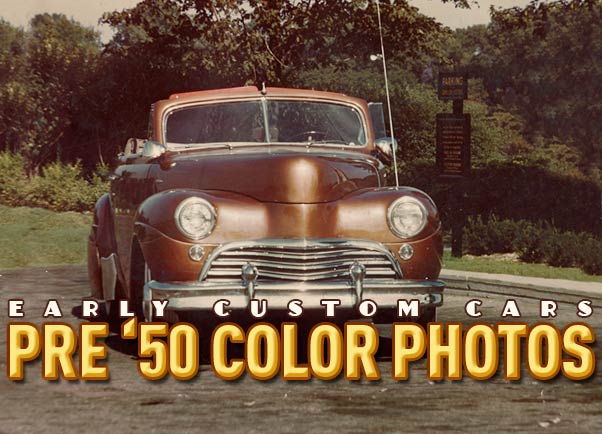





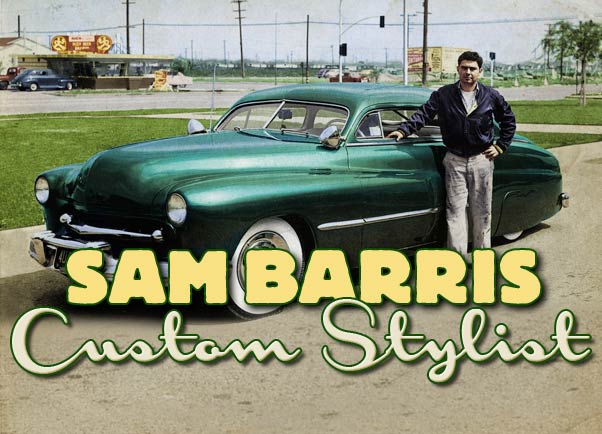
Thank you, Rik. Colors only seen in the teen imagination now reveal themselves, and despite aging (both in the images and this old teen) do not disappoint. They are stunning! Long live the CCC.
Nice article, Rik! Lots of copper in this lineup…haha. In my opinion, these early color photos are pleasing to look at- almost more realistic than the pictures taken today. I don’t know exactly why, but that’s just the way they appear to me (the non-faded ones).
Really interesting to learn that is the very first color photo of a kustom. I had no idea.
Much like early black & white images, these first colour shots seem to have a “life” to them. Somehow the soul of the subject comes through – I don’t know how else to describe it; they just seems to have a personality newer (esp. digital) photos don’t possess.. (Not knocking digital entirely as we have far more documentation now days because of it).
Another fine history lesson. Thanks.
Dave
another great article rik, keep em coming so nice to see them old colors i sure like them dark maroons my self,
thanks Rik….i remember when we scanned the pictures from Jim Street. he was very happy about that cobber brown color and not the only car he gave that color. wasnt there a sedan using the same…and the more i look at it the better i like it..
Yes Jim loved the Mexically bronze paint and he mentioned he painted several of his cars that color. His ’41 Ford convertible, his Lincoln and the Jack Stewart Ford. Those I saw pictures of, but I do not remember a sedan.. at least he did not show any photos of it. I know Jim also had a ’36 Ford two door sedan… but I cannot remember if he ever mentioned the color on it… And yes its amazing how popular this bronze / coper colors were on customs back in the 1940’s.